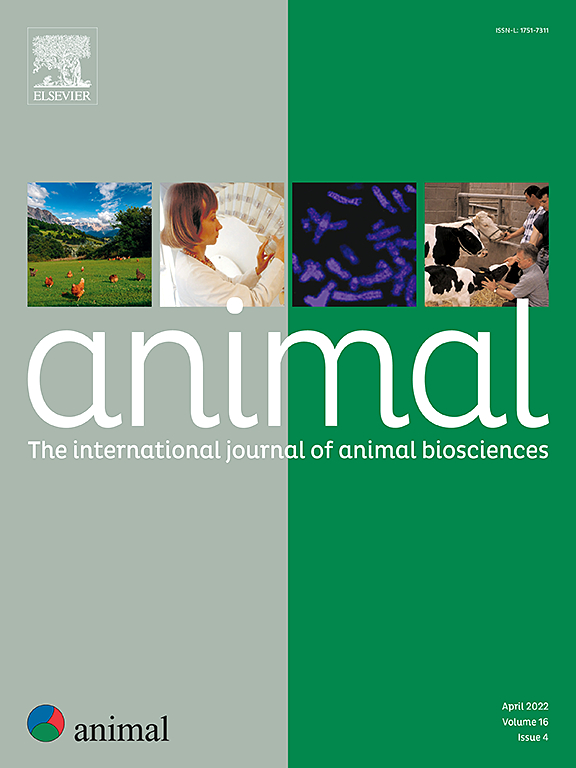A meta-analysis on use of agro-industrial by-products rich in polyphenols in dairy small ruminant nutrition
IF 4.2
2区 农林科学
Q1 AGRICULTURE, DAIRY & ANIMAL SCIENCE
引用次数: 0
Abstract
The recovery and reuse of agro-industrial by-products (AIBP) in livestock feeding fully align with the goals set by the European Union, aimed at achieving climate neutrality by 2050. The literature contains many studies related to the inclusion of these products in ruminant diets, with particular interest in those rich in bioactive substances, such as polyphenols, which can provide various benefits to both animals and productions. However, the reported results, particularly regarding milk production and quality, are highly variable, depending on numerous factors such as species, inclusion level, polyphenol dose, other diet ingredients etc. The objective of this study was to evaluate the effects of dietary supplementation with AIBP rich in polyphenols on milk production and composition, and fatty acid profile in dairy sheep and goat. The systematic search was conducted using Scopus, Web of Science, and PubMed databases. Only studies with sheep and goat were included. The data analysed were extracted from 41 scientific papers and the considered AIBP came from grape, olive, tomato, citrus, cocoa and coffee processing. The effects of AIBP were analysed using random-effects statistical models to examine the standardised mean difference between AIBP and control treatment. The heterogeneity was then explored by a meta-regression. A meta-regression was also used to test the effect of the dosage of polyphenols in the diet (g of polyphenols/kg of diet). A test for subgroup differences was carried out through a meta-analysis considering the by-product type. Supplementation with AIBP did not affect the milk yield either in sheep and goat. Supplementation with AIBP in sheep diet led to an increase in monounsaturated fatty acids (MUFA), oleic acid (OA, C18:1cis-9), vaccenic acid (VA, C18:1trans-11), and to a decrease in saturated fatty acids (SFA). Polyunsaturated fatty acids (PUFA), PUFA n-3, VA, and linolenic acid (C18:3 n3) increased in response to the dosage of polyphenols in sheep diet. In goat, the inclusion of by-products in the diet led to a decrease in SFA and an increase in MUFA, VA, LNA, and rumenic acid (RA, C18:2cis-9,trans-11), while the dosage was never significant. The effects of each by-product on milk production and composition are reported both in sheep and goat species. In conclusion, the addition of AIBP in the diet of sheep and goat did not modify the milk yield but clearly improves its quality through the reduction of SFA and an increase of MUFA, OA, VA, and, in goats, RA.
富含多酚的农工副产品在乳品小反刍动物营养中的应用荟萃分析。
在牲畜饲养中回收和再利用农工副产品(AIBP)完全符合欧盟制定的到2050年实现气候中和的目标。文献中包含了许多关于在反刍动物饮食中加入这些产品的研究,特别关注那些富含生物活性物质的产品,如多酚,它可以为动物和产品提供各种好处。然而,报告的结果,特别是关于牛奶的产量和质量,是高度可变的,取决于许多因素,如物种,包含水平,多酚剂量,其他饮食成分等。本研究旨在评价饲粮中添加富含多酚的AIBP对奶羊和山羊产奶量、乳成分和脂肪酸谱的影响。系统检索使用Scopus、Web of Science和PubMed数据库。只包括绵羊和山羊的研究。分析的数据摘自41篇科学论文,考虑的AIBP来自葡萄、橄榄、番茄、柑橘、可可和咖啡的加工过程。采用随机效应统计模型分析AIBP的效果,以检验AIBP与对照治疗之间的标准化平均差异。然后通过元回归探讨异质性。采用元回归法检验日粮中多酚含量(g /kg日粮)的影响。通过考虑副产物类型的荟萃分析对亚组差异进行检验。添加AIBP对绵羊和山羊的产奶量也没有影响。在绵羊日粮中添加AIBP可增加单不饱和脂肪酸(MUFA)、油酸(OA, c18:1 - cis-9)、苗酸(VA, c18:1反式-11),降低饱和脂肪酸(SFA)。绵羊日粮中多酚添加量增加,多不饱和脂肪酸(PUFA)、PUFA n-3、VA和亚麻酸(C18:3 n3)含量增加。在山羊中,在日粮中加入副产物导致SFA减少,MUFA、VA、LNA和瘤胃酸(RA, c18: 2is -9,反式-11)增加,但剂量不显著。每种副产品对绵羊和山羊的产奶量和成分的影响均有报道。综上所述,在绵羊和山羊日粮中添加AIBP没有改变产奶量,但通过降低SFA,增加MUFA、OA、VA和山羊RA,明显提高了产奶量。
本文章由计算机程序翻译,如有差异,请以英文原文为准。
求助全文
约1分钟内获得全文
求助全文
来源期刊

Animal
农林科学-奶制品与动物科学
CiteScore
7.50
自引率
2.80%
发文量
246
审稿时长
3 months
期刊介绍:
Editorial board
animal attracts the best research in animal biology and animal systems from across the spectrum of the agricultural, biomedical, and environmental sciences. It is the central element in an exciting collaboration between the British Society of Animal Science (BSAS), Institut National de la Recherche Agronomique (INRA) and the European Federation of Animal Science (EAAP) and represents a merging of three scientific journals: Animal Science; Animal Research; Reproduction, Nutrition, Development. animal publishes original cutting-edge research, ''hot'' topics and horizon-scanning reviews on animal-related aspects of the life sciences at the molecular, cellular, organ, whole animal and production system levels. The main subject areas include: breeding and genetics; nutrition; physiology and functional biology of systems; behaviour, health and welfare; farming systems, environmental impact and climate change; product quality, human health and well-being. Animal models and papers dealing with the integration of research between these topics and their impact on the environment and people are particularly welcome.
 求助内容:
求助内容: 应助结果提醒方式:
应助结果提醒方式:


